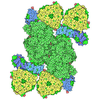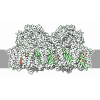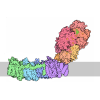[English] 日本語
 Yorodumi
Yorodumi- PDB-6vpv: Trimeric Photosystem I from the High-Light Tolerant Cyanobacteria... -
+ Open data
Open data
- Basic information
Basic information
| Entry | Database: PDB / ID: 6vpv | ||||||
|---|---|---|---|---|---|---|---|
| Title | Trimeric Photosystem I from the High-Light Tolerant Cyanobacteria Cyanobacterium Aponinum | ||||||
 Components Components |
| ||||||
 Keywords Keywords | PHOTOSYNTHESIS / Photosystem I / Membrane Protein / PSI | ||||||
| Function / homology |  Function and homology information Function and homology information: / photosystem I reaction center / photosystem I / photosynthetic electron transport in photosystem I / photosystem I / chlorophyll binding / plasma membrane-derived thylakoid membrane / membrane => GO:0016020 / photosynthesis / endomembrane system ...: / photosystem I reaction center / photosystem I / photosynthetic electron transport in photosystem I / photosystem I / chlorophyll binding / plasma membrane-derived thylakoid membrane / membrane => GO:0016020 / photosynthesis / endomembrane system / 4 iron, 4 sulfur cluster binding / oxidoreductase activity / electron transfer activity / magnesium ion binding / metal ion binding Similarity search - Function | ||||||
| Biological species |  Cyanobacterium aponinum 0216 (bacteria) Cyanobacterium aponinum 0216 (bacteria) | ||||||
| Method | ELECTRON MICROSCOPY / single particle reconstruction / cryo EM / Resolution: 2.7 Å | ||||||
 Authors Authors | Dobson, Z. / Toporik, H. / Vaughn, N. / Lin, S. / Williams, D. / Fromme, P. / Mazor, Y. | ||||||
 Citation Citation |  Journal: Elife / Year: 2021 Journal: Elife / Year: 2021Title: The structure of photosystem I from a high-light-tolerant cyanobacteria. Authors: Zachary Dobson / Safa Ahad / Jackson Vanlandingham / Hila Toporik / Natalie Vaughn / Michael Vaughn / Dewight Williams / Michael Reppert / Petra Fromme / Yuval Mazor /  Abstract: Photosynthetic organisms have adapted to survive a myriad of extreme environments from the earth's deserts to its poles, yet the proteins that carry out the light reactions of photosynthesis are ...Photosynthetic organisms have adapted to survive a myriad of extreme environments from the earth's deserts to its poles, yet the proteins that carry out the light reactions of photosynthesis are highly conserved from the cyanobacteria to modern day crops. To investigate adaptations of the photosynthetic machinery in cyanobacteria to excessive light stress, we isolated a new strain of cyanobacteria, 0216, from the extreme light environment of the Sonoran Desert. Here we report the biochemical characterization and the 2.7 Å resolution structure of trimeric photosystem I from this high-light-tolerant cyanobacterium. The structure shows a new conformation of the PsaL C-terminus that supports trimer formation of cyanobacterial photosystem I. The spectroscopic analysis of this photosystem I revealed a decrease in far-red absorption, which is attributed to a decrease in the number of long- wavelength chlorophylls. Using these findings, we constructed two chimeric PSIs in sp. PCC 6803 demonstrating how unique structural features in photosynthetic complexes can change spectroscopic properties, allowing organisms to thrive under different environmental stresses. | ||||||
| History |
|
- Structure visualization
Structure visualization
| Movie |
 Movie viewer Movie viewer |
|---|---|
| Structure viewer | Molecule:  Molmil Molmil Jmol/JSmol Jmol/JSmol |
- Downloads & links
Downloads & links
- Download
Download
| PDBx/mmCIF format |  6vpv.cif.gz 6vpv.cif.gz | 1.6 MB | Display |  PDBx/mmCIF format PDBx/mmCIF format |
|---|---|---|---|---|
| PDB format |  pdb6vpv.ent.gz pdb6vpv.ent.gz | 1.4 MB | Display |  PDB format PDB format |
| PDBx/mmJSON format |  6vpv.json.gz 6vpv.json.gz | Tree view |  PDBx/mmJSON format PDBx/mmJSON format | |
| Others |  Other downloads Other downloads |
-Validation report
| Summary document |  6vpv_validation.pdf.gz 6vpv_validation.pdf.gz | 16.3 MB | Display |  wwPDB validaton report wwPDB validaton report |
|---|---|---|---|---|
| Full document |  6vpv_full_validation.pdf.gz 6vpv_full_validation.pdf.gz | 16.9 MB | Display | |
| Data in XML |  6vpv_validation.xml.gz 6vpv_validation.xml.gz | 284.1 KB | Display | |
| Data in CIF |  6vpv_validation.cif.gz 6vpv_validation.cif.gz | 373.4 KB | Display | |
| Arichive directory |  https://data.pdbj.org/pub/pdb/validation_reports/vp/6vpv https://data.pdbj.org/pub/pdb/validation_reports/vp/6vpv ftp://data.pdbj.org/pub/pdb/validation_reports/vp/6vpv ftp://data.pdbj.org/pub/pdb/validation_reports/vp/6vpv | HTTPS FTP |
-Related structure data
| Related structure data |  21320MC M: map data used to model this data C: citing same article ( |
|---|---|
| Similar structure data |
- Links
Links
- Assembly
Assembly
| Deposited unit | 
|
|---|---|
| 1 |
|
- Components
Components
-Photosystem I P700 chlorophyll a apoprotein ... , 2 types, 6 molecules Aa1Bb2
| #1: Protein | Mass: 81754.039 Da / Num. of mol.: 3 / Source method: isolated from a natural source / Source: (natural)  Cyanobacterium aponinum 0216 (bacteria) / Strain: 0216 / References: UniProt: A0A2G3P9X3, photosystem I Cyanobacterium aponinum 0216 (bacteria) / Strain: 0216 / References: UniProt: A0A2G3P9X3, photosystem I#2: Protein | Mass: 81865.945 Da / Num. of mol.: 3 / Source method: isolated from a natural source / Source: (natural)  Cyanobacterium aponinum 0216 (bacteria) / Strain: 0216 / References: UniProt: K9Z2J7, photosystem I Cyanobacterium aponinum 0216 (bacteria) / Strain: 0216 / References: UniProt: K9Z2J7, photosystem I |
|---|
-Protein , 2 types, 6 molecules Cc3Ff6
| #3: Protein | Mass: 8692.039 Da / Num. of mol.: 3 / Source method: isolated from a natural source / Source: (natural)  Cyanobacterium aponinum 0216 (bacteria) / Strain: 0216 / References: UniProt: A0A2G3PD04, photosystem I Cyanobacterium aponinum 0216 (bacteria) / Strain: 0216 / References: UniProt: A0A2G3PD04, photosystem I#6: Protein | Mass: 15665.845 Da / Num. of mol.: 3 / Source method: isolated from a natural source / Source: (natural)  Cyanobacterium aponinum 0216 (bacteria) / Strain: 0216 / References: UniProt: A0A2G3PEV5 Cyanobacterium aponinum 0216 (bacteria) / Strain: 0216 / References: UniProt: A0A2G3PEV5 |
|---|
-Photosystem I reaction center subunit ... , 7 types, 21 molecules Dd4Ee5Ii7Jj8Kk9Ll0Mmz
| #4: Protein | Mass: 15647.748 Da / Num. of mol.: 3 / Source method: isolated from a natural source / Source: (natural)  Cyanobacterium aponinum 0216 (bacteria) / Strain: 0216 / References: UniProt: A0A2G3PAQ0 Cyanobacterium aponinum 0216 (bacteria) / Strain: 0216 / References: UniProt: A0A2G3PAQ0#5: Protein | Mass: 7634.534 Da / Num. of mol.: 3 / Source method: isolated from a natural source / Source: (natural)  Cyanobacterium aponinum 0216 (bacteria) / Strain: 0216 / References: UniProt: A0A2G3PEU8 Cyanobacterium aponinum 0216 (bacteria) / Strain: 0216 / References: UniProt: A0A2G3PEU8#7: Protein/peptide | Mass: 3913.726 Da / Num. of mol.: 3 / Source method: isolated from a natural source / Source: (natural)  Cyanobacterium aponinum 0216 (bacteria) / Strain: 0216 / References: UniProt: K9Z9J3 Cyanobacterium aponinum 0216 (bacteria) / Strain: 0216 / References: UniProt: K9Z9J3#8: Protein/peptide | Mass: 4354.158 Da / Num. of mol.: 3 / Source method: isolated from a natural source / Source: (natural)  Cyanobacterium aponinum 0216 (bacteria) / Strain: 0216 / References: UniProt: A0A2G3PEV6 Cyanobacterium aponinum 0216 (bacteria) / Strain: 0216 / References: UniProt: A0A2G3PEV6#9: Protein | Mass: 7860.323 Da / Num. of mol.: 3 / Source method: isolated from a natural source / Source: (natural)  Cyanobacterium aponinum 0216 (bacteria) / Strain: 0216 / References: UniProt: A0A2G3P6W6 Cyanobacterium aponinum 0216 (bacteria) / Strain: 0216 / References: UniProt: A0A2G3P6W6#10: Protein | Mass: 16779.295 Da / Num. of mol.: 3 / Source method: isolated from a natural source / Source: (natural)  Cyanobacterium aponinum 0216 (bacteria) / Strain: 0216 / References: UniProt: A0A2G3P7D5 Cyanobacterium aponinum 0216 (bacteria) / Strain: 0216 / References: UniProt: A0A2G3P7D5#11: Protein/peptide | Mass: 3278.920 Da / Num. of mol.: 3 / Source method: isolated from a natural source / Source: (natural)  Cyanobacterium aponinum 0216 (bacteria) / Strain: 0216 / References: UniProt: A0A2G3PA81 Cyanobacterium aponinum 0216 (bacteria) / Strain: 0216 / References: UniProt: A0A2G3PA81 |
|---|
-Non-polymers , 8 types, 384 molecules 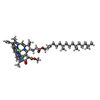
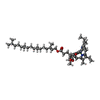
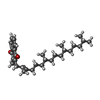
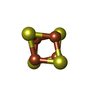
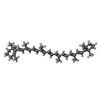
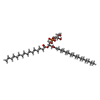
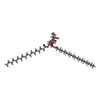
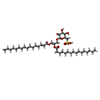







| #12: Chemical | | #13: Chemical | ChemComp-CLA / #14: Chemical | ChemComp-PQN / #15: Chemical | ChemComp-SF4 / #16: Chemical | ChemComp-BCR / #17: Chemical | ChemComp-LHG / #18: Chemical | #19: Chemical | |
|---|
-Details
| Has ligand of interest | N |
|---|---|
| Has protein modification | Y |
-Experimental details
-Experiment
| Experiment | Method: ELECTRON MICROSCOPY |
|---|---|
| EM experiment | Aggregation state: PARTICLE / 3D reconstruction method: single particle reconstruction |
- Sample preparation
Sample preparation
| Component | Name: Trimeric PSI from a High Light tolerant cyanobacteria, Cyanobacterium aponinum Type: COMPLEX / Entity ID: #1-#11 / Source: NATURAL |
|---|---|
| Source (natural) | Organism:  Cyanobacterium aponinum 0216 (bacteria) / Strain: 216 Cyanobacterium aponinum 0216 (bacteria) / Strain: 216 |
| Buffer solution | pH: 8 |
| Specimen | Embedding applied: NO / Shadowing applied: NO / Staining applied: NO / Vitrification applied: YES |
| Specimen support | Details: unspecified |
| Vitrification | Cryogen name: ETHANE |
- Electron microscopy imaging
Electron microscopy imaging
| Experimental equipment |  Model: Titan Krios / Image courtesy: FEI Company |
|---|---|
| Microscopy | Model: FEI TITAN KRIOS |
| Electron gun | Electron source:  FIELD EMISSION GUN / Accelerating voltage: 300 kV / Illumination mode: FLOOD BEAM FIELD EMISSION GUN / Accelerating voltage: 300 kV / Illumination mode: FLOOD BEAM |
| Electron lens | Mode: BRIGHT FIELD |
| Image recording | Electron dose: 1.53 e/Å2 / Detector mode: SUPER-RESOLUTION / Film or detector model: GATAN K2 SUMMIT (4k x 4k) |
- Processing
Processing
| EM software |
| ||||||||||||||||||||||||
|---|---|---|---|---|---|---|---|---|---|---|---|---|---|---|---|---|---|---|---|---|---|---|---|---|---|
| CTF correction | Type: PHASE FLIPPING AND AMPLITUDE CORRECTION | ||||||||||||||||||||||||
| Symmetry | Point symmetry: C3 (3 fold cyclic) | ||||||||||||||||||||||||
| 3D reconstruction | Resolution: 2.7 Å / Resolution method: FSC 0.143 CUT-OFF / Num. of particles: 75290 / Symmetry type: POINT |
 Movie
Movie Controller
Controller




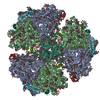
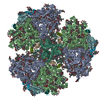
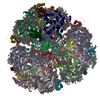
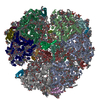
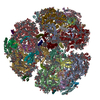
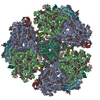
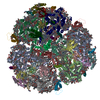
 PDBj
PDBj